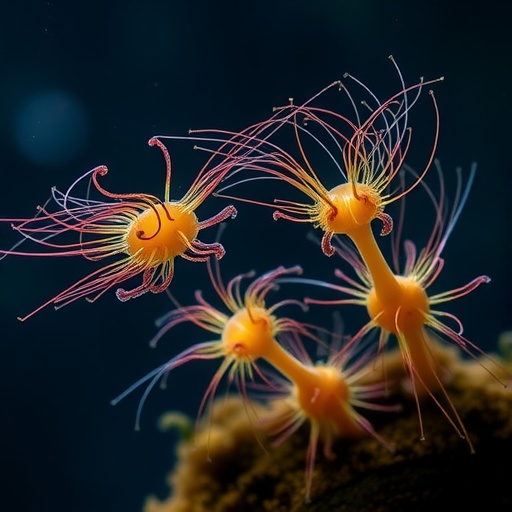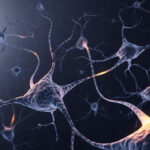
In the evolving landscape of sustainable agriculture, a novel approach to animal feed production is gaining remarkable momentum, promising to revolutionize the aquaculture and livestock industries alike. Scientists Guo, Liu, and Yang have pioneered a groundbreaking method to domesticate rotifers, microscopic aquatic animals, using naturally occurring phytoplankton harvested from eutrophic waters. This innovative development, as detailed in their recent publication in npj Sustainable Agriculture, offers a potentially transformative avenue for eco-friendly feed production that could alleviate the environmental burdens of conventional animal feed sources.
Rotifers, tiny zooplankton less than a millimeter in size, have long been recognized for their nutritional value and utility in aquaculture. Yet, their widespread commercial use has faced significant challenges, primarily related to cost-effective production and sustainable feeding practices. Traditional cultivation methods often require expensive formulated diets, which not only elevate operational costs but also increase reliance on non-renewable feed inputs. The research team’s approach to employ indigenous phytoplankton blooms from nutrient-rich, or eutrophic, water systems as a natural feed source for rotifers cleverly circumvents these limitations, harnessing an abundant and renewable biological resource.
Eutrophic waters, characterized by high nutrient concentrations—particularly nitrogen and phosphorus—are notorious for algal blooms that can disrupt aquatic ecosystems. While these blooms are usually considered environmental nuisances due to oxygen depletion and fish kills, Guo and colleagues have ingeniously repurposed this ecological challenge into an opportunity. By isolating and optimizing the natural phytoplankton community that flourishes in these waters, they create a sustainable, self-supporting system for rotifer domestication, shifting the narrative from pollutant mitigation to productive resource utilization.
.adsslot_E5J96Vzsq1{ width:728px !important; height:90px !important; }
@media (max-width:1199px) { .adsslot_E5J96Vzsq1{ width:468px !important; height:60px !important; } }
@media (max-width:767px) { .adsslot_E5J96Vzsq1{ width:320px !important; height:50px !important; } }
ADVERTISEMENT
The technical foundation of this method rests on the selective harvesting and cultivation of phytoplankton species adapted to eutrophic conditions. These microorganisms serve as a primary energy source for rotifers, enabling the latter to grow at accelerated rates with enhanced nutritional profiles tailored for aquatic animal feed. The researchers meticulously characterized the phytoplankton assemblages, emphasizing species composition, biochemical content, and growth dynamics to ensure compatibility with rotifer dietary requirements. This intricate balance is crucial, as it directly influences rotifer biomass yield, reproductive rates, and overall nutritional enhancements necessary for downstream applications.
Beyond the immediate ecological and economic implications, the team’s protocol showcases remarkable efficiency gains. By leveraging naturally occurring phytoplankton rather than synthetic or imported feedstocks, the rotifer rearing process becomes less resource-intensive and more resilient to market fluctuations affecting feed ingredient availability. This approach also diminishes the carbon footprint of feed production, addressing global calls for climate-smart agricultural innovations. Notably, utilizing eutrophic waters taps into a vast, underexploited resource that simultaneously contributes to biodiversity conservation through mitigating harmful algal bloom severity.
One of the significant hurdles the authors overcame was ensuring that the rotifers cultivated in this system maintained consistent high nutritional quality, particularly concerning essential fatty acids such as omega-3 and omega-6, vital for fish and crustaceans in aquaculture. Extensive biochemical assays demonstrated that rotifers fed on natural phytoplankton had comparable, if not superior, lipid profiles relative to those raised on conventional diets. This finding is particularly relevant since the nutritional quality of live feeds directly affects the health, growth rate, and disease resistance of cultured species.
Moreover, the successful domestication process described involves strategic cultivation management, including controlled exposure of rotifers to specific phytoplankton densities and periodic harvesting to optimize population turnover. The researchers implemented a semi-continuous culture system, balancing nutrient input with rotifer biomass extraction rates, which ensures sustainable operation without undue ecological disruption of the source water bodies. This scalability consideration is pivotal, as commercial aquaculture demands reliable, high-volume live feed production to meet global market demands.
Intriguingly, the research also highlights potential bioremediation benefits. By harvesting phytoplankton from eutrophic waters, the method effectively removes excess nutrients, helping restore aquatic ecosystems impaired by runoff and pollution. This dual functionality—resource production coupled with environmental remediation—positions the approach as a model for integrated sustainable management. It aligns with principles of circular bioeconomy, where waste streams are transformed into valuable inputs, significantly contributing to sustainability goals at the intersection of agriculture and environmental conservation.
The socioeconomic implications cannot be overlooked. Small- and medium-scale aquaculture operations, particularly in developing regions, often face prohibitive costs associated with procuring high-quality live feeds. This domestication technique offers a low-cost, locally adaptable solution that could democratize access to premium feeds, potentially bolstering food security and livelihoods. By fostering endogenous production systems, communities reduce their dependence on imports and volatile commodity prices, enhancing resilience and self-sufficiency.
From a scientific perspective, the work also advances understanding of trophic interactions and energy transfer in aquatic food webs. The meticulous documentation of rotifer-phytoplankton dynamics enriches ecological theory, particularly regarding nutrient cycling and population ecology in eutrophic ecosystems. Such knowledge has broad implications, providing a foundation for designing more efficient aquaculture systems that emulate natural processes, thereby reducing environmental footprints.
Looking ahead, the authors suggest several avenues for future research. One promising direction involves genetic selection and breeding of rotifer strains optimized for growth performance on specific phytoplankton diets. This bioengineering could further enhance feed conversion efficiency, nutritional value, and disease resistance, accelerating industry adaptation. Parallel efforts may explore the potential of this system to support other live feed species, such as Artemia or copepods, broadening applicability across aquaculture sectors.
The global demand for sustainable animal protein is increasing exponentially, straining traditional feed resources and challenging environmental stewardship. Innovations like the domestication of rotifers fed on natural phytoplankton from eutrophic waters embody the kind of integrative, ecosystem-based solutions needed to meet these challenges. By transforming problematic algal blooms into valuable inputs, Guo, Liu, and Yang have not only introduced a sophisticated technical approach but also crafted a narrative of hope—where sustainability and productivity coalesce through ingenuity.
As the aquaculture industry continues to grow, driven by population increase and shifting dietary preferences, the pressure to reduce reliance on fishmeal and soy-based feeds intensifies. The method detailed here offers a credible pathway toward circularity and resilience. Moreover, it underscores the importance of interdisciplinary collaboration, merging ecology, microbiology, and agricultural engineering to rethink how natural resources can be harnessed effectively.
Finally, the technique also invites broader reflection on human interaction with aquatic ecosystems. By leveraging eutrophic waters—often victims of anthropogenic activity—and transforming them into production hubs, this research challenges us to reconsider what constitutes waste and value in nature. It highlights the potential of scientific innovation not merely to mitigate damage but to reset the relationship between agriculture and the environment on more sustainable, mutually beneficial terms.
As these findings galvanize interest worldwide, commercial-scale trials and policy integration will be vital to realize the full potential of this technology. If successful, this domestication strategy could herald a new era in sustainable animal feed production—one where ecosystem challenges are reimagined as solutions, powering a future of abundant, healthy food nourished by the overlooked productivity of eutrophic waters.
Subject of Research: Domestication of rotifers as animal feed using natural phytoplankton from eutrophic waters.
Article Title: Domesticating rotifer as animal feed using natural phytoplankton from eutrophic waters.
Article References:
Guo, L., Liu, H. & Yang, G. Domesticating rotifer as animal feed using natural phytoplankton from eutrophic waters. npj Sustain. Agric. 3, 38 (2025). https://doi.org/10.1038/s44264-025-00082-0
Image Credits: AI Generated
Tags: algal blooms in aquaculturecost-effective feed alternativesdomestication of rotiferseco-friendly animal feed productionenvironmental impact of feed productioneutrophic water utilizationinnovative aquaculture solutionsnatural phytoplankton feed sourcesnutritional value of rotifersrenewable biological resourcessustainable aquaculture practicessustainable livestock feeding



